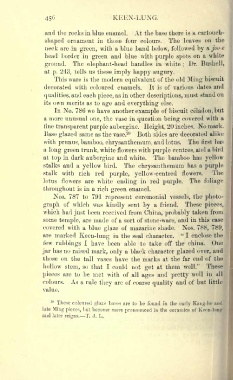Page 494 - Chinese Porcelain Vol II, Galland
P. 494
456 KEEN-LUNG.
and the rocks in blue enamel. At the base there is a cartouch-
shaped ornament in those four colours. The leaves on the
neck are in with a blue band below, followed by a
green, joo-e
head border in and blue with on a white
green purple spots
ground. The elephant-head handles in white ; Dr. Bushell,
at p. 243, tells us these imply happy augury.
This ware is the modern of the old biscuit
equivalent Ming
decorated with coloured enamels. It is of various dates and
and each as in other must stand on
qualities, piece, descriptions,
its own merits as to and else.
age everything
In No. 786 we have another of biscuit celadon, but
example
a more unusual one, the vase in covered with a
question being
fine 20 inches. No mark.
transparent purple aubergine. Height,
Base 28 Both sides are decorated alike
glazed same as the vase.
with The first has
prunus, bamboo, chrysanthemum, and lotus.
a long green trunk, white flowers with purple centres, and a bird
at in dark and white. The bamboo has
top aubergine yellow
stalks and a bird. The has a
yellow chrysanthemum purple
stalk with rich red flowers. The
purple, yellow-centred
lotus flowers are white in red The foliage
ending purple.
throughout is in a rich green enamel.
Nos. 787 to 791 ceremonial vessels, the
represent photo-
graph of which was kindly sent by a friend. These pieces,
which had taken from
just been received from China, probably
some temple, are made of a sort of stone-ware, and in this case
covered with a blue of mazarine shade. Nos. 788, 789,
glaze
are marked in the seal character. " I enclose the
Keen-lung
few I have been able to take off the china. One
rubbings
a black character glazed over, and
jar has no raised mark, only
those on the tall vases have the marks at the far end of the
hollow stem, so that I could not at them well." These
get
pieces are to be met with of all ages and pretty well in all
colours. As a rule are of coarse and of but little
they quality
value.
8
These coloured glaze bases are to be found in the early Kang-he and
late Ming pieces, but become more pronounced in the ceramics of Keen-lung
and later T. J. L.
reigns.

